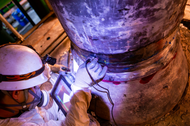PAUT in Lieu of RT in Oil & Gas Standards: Enhancing Inspection Efficiency & Accuracy
Posted by VERMON NDT on May 10th 2024
In NDT Phased Array Ultrasonic Testing (PAUT) has emerged as a powerful alternative to traditional radiography methods. Its versatility, accuracy, and efficiency make it an invaluable tool across various industries. Here we explore how PAUT is utilized in lieu of radiography via applications, relevant standards, and the advantages it offers.
PAUT finds extensive application across industries such as aerospace, oil and gas, manufacturing, and infrastructure. Its adaptability allows for flaw detection, thickness measurements, weld inspections, and material characterization, among others. One of its significant advantages lies in its ability to provide real-time imaging and data interpretation, enabling fast reporting and even prompt decision-making during inspections.
PAUT offers several other advantages over radiography, making it a preferred choice in many scenarios. Unlike radiography, PAUT is non-radioactive, eliminating radiation hazards and reducing safety concerns for personnel. PAUT is easier to set up and can be conducted during regular working hours without a controlled area to limit exposure to radioactive materials, making it logistically more desirable. Moreover, its capability to inspect complex geometries and varying material thicknesses surpasses the limitations of radiography, enhancing inspection efficiency and accuracy. This is particularly true when inspecting for cracks and lack of fusion or planar flaws.
Standards and Regulations
Several standards and regulations endorse the use of PAUT, emphasizing its reliability and effectiveness. Among these are numerous code cases from the American Society of Mechanical Engineers (ASME) which have been demonstrated and validated by EPRI and include:
- Code Case - 2235 (Pressure Vessels and Power Boilers)
- B31.1 CC 179 and 168 (Pressure piping, Power Piping)
- Sect III- CC N-659-2
- Sect I & VIII - CC 2235 - 9
- Sect XI – CC N-713168, N-713
- Section V
These are all key to ensuring safety in the oil & gas industry. Meanwhile the structures that support refineries, off-shore platforms and other structures are governed by the American Welding Society (AWS) standards D1.1 (Structural Welding Code - Steel) and D1.5 (Bridge Welding Code) are paramount in ensuring the quality and integrity of welded structures. PAUT's acceptance in these standards underscores its credibility and importance in the oil and gas industry.PAUT as an approved method for weld examination, materials testing, and corrosion assessment, further validating its widespread adoption.
Precision and Reliability
In the pursuit of precision and reliability, the choice of PAUT probes is crucial. Vermon NDT stands out for its commitment to delivering highly accurate and repeatable results over prolonged periods of inspection. Their PAUT probes are engineered to withstand rigorous testing environments, ensuring consistent performance and durability. This reliability enables precise characterization of degradation over time, empowering industries to monitor structural health and implement timely maintenance strategies.
Phased Array Ultrasonic Testing has revolutionized the landscape of NDT, Fitness-For-Service, and Mechanical Integrity inspection, offering unparalleled versatility and efficiency. Its adoption in various industries, coupled with endorsement from prominent standards and regulations, solidifies its position as a reliable inspection technique. When paired with advanced PAUT probes from Vermon NDT, the accuracy and repeatability of inspections are further enhanced, enabling precise assessment of structural integrity and facilitating proactive maintenance measures. As industries continue to prioritize safety and quality, PAUT remains indispensable in ensuring the reliability and longevity of critical infrastructure and components.

